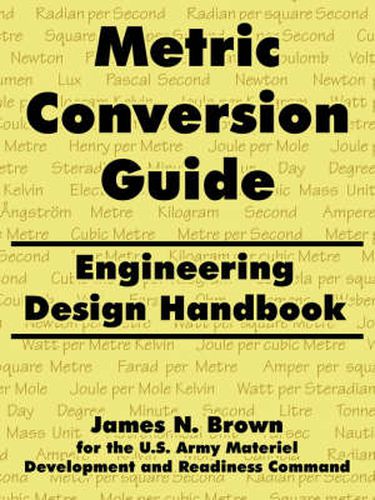Readings Newsletter
Become a Readings Member to make your shopping experience even easier.
Sign in or sign up for free!
You’re not far away from qualifying for FREE standard shipping within Australia
You’ve qualified for FREE standard shipping within Australia
The cart is loading…






This title is printed to order. This book may have been self-published. If so, we cannot guarantee the quality of the content. In the main most books will have gone through the editing process however some may not. We therefore suggest that you be aware of this before ordering this book. If in doubt check either the author or publisher’s details as we are unable to accept any returns unless they are faulty. Please contact us if you have any questions.
The general purpose of this handbook is to prepare scientists, engineers, and technicians of the U.S. Army Materiel Development and Readiness Command (DARCOM) for increasing use of the International Systems of Units (SI) or, as it is frequently referred to, the metric system. The specific objectives are to give DARCOM personnel (1) the tools required to convert the units of physical quantities and equations to SI units, (2) the information needed to correctly interpret specifications and documentation using the SI, and (3) the information needed to generate specifications and prepared documentation in SI units. Chapter 1 presents a paragraph outline of the handbook to facilitate its use, and a brief history of the introduction of and increasing use of the SI in the US. Definitions, rules, and conventions fundamental to the SI and its use are to be found in Chapters 2 and 3. Methods for converting non-SI units to SI units are given in Chapter 4. The methods make use of unit equalities and, if applied rigorously, will minimize or eliminate errors in unit conversions. A relatively simple method is presented for modifying equations such that equations derived for use with non-SI units can be used with SI units. Tables of unit equalities, experimentally determined constants expressed in SI units, and dimensionless quantities are given in Chapter 5. Chapter 6 is concerned with the use of SI in military engineering drawings, and covers dual dimensioning and conversion of the units of dimensions. Sample calculations illustrating methods of converting units and modifying equations are given in Chapter 7.
$9.00 standard shipping within Australia
FREE standard shipping within Australia for orders over $100.00
Express & International shipping calculated at checkout
This title is printed to order. This book may have been self-published. If so, we cannot guarantee the quality of the content. In the main most books will have gone through the editing process however some may not. We therefore suggest that you be aware of this before ordering this book. If in doubt check either the author or publisher’s details as we are unable to accept any returns unless they are faulty. Please contact us if you have any questions.
The general purpose of this handbook is to prepare scientists, engineers, and technicians of the U.S. Army Materiel Development and Readiness Command (DARCOM) for increasing use of the International Systems of Units (SI) or, as it is frequently referred to, the metric system. The specific objectives are to give DARCOM personnel (1) the tools required to convert the units of physical quantities and equations to SI units, (2) the information needed to correctly interpret specifications and documentation using the SI, and (3) the information needed to generate specifications and prepared documentation in SI units. Chapter 1 presents a paragraph outline of the handbook to facilitate its use, and a brief history of the introduction of and increasing use of the SI in the US. Definitions, rules, and conventions fundamental to the SI and its use are to be found in Chapters 2 and 3. Methods for converting non-SI units to SI units are given in Chapter 4. The methods make use of unit equalities and, if applied rigorously, will minimize or eliminate errors in unit conversions. A relatively simple method is presented for modifying equations such that equations derived for use with non-SI units can be used with SI units. Tables of unit equalities, experimentally determined constants expressed in SI units, and dimensionless quantities are given in Chapter 5. Chapter 6 is concerned with the use of SI in military engineering drawings, and covers dual dimensioning and conversion of the units of dimensions. Sample calculations illustrating methods of converting units and modifying equations are given in Chapter 7.